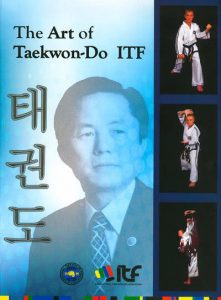Written Educational Resources by General Choi
The Original Taekwon-Do that began in the ROK Army as Military Taekwon-Do is perhaps the most thoroughly documented Martial Art ever.
Efforts that helped make this a reality started when a young man name Choi Hong-Hi graduated from the 1st Military Academy at the start of 1946, just months after Korea was liberated by a long term occupation by Imperial Japan.
The newly Commissioned 2nd Lieutenant Choi kept a daily journal as he began to teach the soldiers under his command when he was deployed to KwangJu as a Company Commander. His notes would include Martial Art moves that he arranged in Patterns that he named after great Korean Patriots or significant historical events or themes of Korea.
This founding member of the ROK Army was fiercely determined to create Korea’s own modern Martial Art.
In 1959 he wrote the first book ever on Taekwon-Do, the Art he named and received Presidential authority for just a few years earlier. This book is indeed very rare as copies of his books were ordered destroyed by the military dictatorship after Choi, now a 2-Star Major General fled for his safety in 1972 to live a life of exile, away from the dictator he openly opposed.
Thankfully one of General Choi’s protégées, Lt. Colonel Kim Soo-Ryun defied the order and preserved a copy that is now on display in the museum at the Taekwondowon in MuJu, Korea.
Grandmaster Jung Woo-Jin has preserved another known copy and a digital version is available as an historical artifact. This treasure of history contains the first 5 Korean Patterns, then called Hyungs ever devised. They were Hwa-Rang, Chung-Mu, Ul-Ji, U-Nam and Sam-Il.
It was written using both Korean HanGul and Chinese HanJa. By 1960, just the following year a 2nd edition was already needed. This printing however removed the Pattern U-Nam, as it was named after Korea’s first President Dr. Rhee, who ran from the Country as a result of widespread protests against the corruption of his autocratic rule.
General Choi then authored a new book on Taekwon-Do in 1965. This was the first book ever on Taekwon-Do in the English language.
There was also a Korean language version of the book as well. This was the book that Ambassador Choi distributed when he took his ROK government sponsored Kukki Taekwon-Do Goodwill Tour around the world that same year.
The book played a part in helping to cement Taekwon-Do as a Korean Martial Art of Self Defense as well as entice other Martial Artists to adopt this new system, which in turn became the base for establishing the ITF the very next year (1966).
He was able to include 16 more Patterns, bring the total to 20.
This book was reprinted a couple of times, including 1968 and a printing by Grandmaster Park Jong-Soo in 2007.
The 1965 Korean edition served as the basis for the 1966 ROK Army Taekwon-Do Manual. This book was issued to the soldiers for their training until the mid 1970s when they switched training methods after General Choi exiled from Korea.
The next book written by General Choi was unprecedented in the Martial Arts. It was a textbook that contained 519 pages and became commonly referred to as the “bible of Taekwon-Do.”
This work more clearly showed the progress away from the Karate roots that were still somewhat evident in his pervious 2 books.
It also contained his signature 24 Patterns with the addition of Eui-Am, Yon-Gae, Moon-Moo and So-San Tuls. The book was so popular that another printing had to be made the very next year.
The so-called “bible of Taekwon-Do” had 6 editions and 2 reprints from 1972 to 1986. Since the 1972 textbook by General Choi, other Martial Arts have published comprehensive books as well.
However no other Martial Art in history has ever had a 15 Volume set of Encyclopedias that so fully documented their Art. General Choi did this when he finished the Encyclopedia of Taekwon-Do in 1983.

It has been described as having approximately 5,000 pages and 30,000 photographs. It took until 1985 to actually be printed, as the military dictatorship exerted pressure through the arm of the KCIA preventing any Korean from assisting General Choi with this venture. Luckily Grandmaster Jung Woo-Jin bravely took on the responsibility and so far 5 editions have been printed.
General Choi realized the benefit of having a single volume condensed version of the Encyclopedia so students could take it to class and seminars. So starting in 1988 there have been 6 editions of the Condensed Encyclopedia.
General Choi saw fit to search for some of the wisest sayings and axioms that have been written since recorded time. He translated them and consolidated some of the best in a Moral Guidebook he produced. This incredible Korean National and Patriot worked tirelessly over his lifetime, constantly circling the globe to teach Taekwon-Do and introduce others to Korean culture, their history and etiquette, as well as time honored wisdom from the Orient and other great philosophers of the world.
Luckily for us he daily journal that he kept for decades also served the basis for his 3 Volume set of Memoirs. Volumes 1 and 2 have been written in English and Korean, while Volume 3 has only been written in Korean and is awaiting an English translation.
The written works of Ambassador Choi Hong-Hi have been translated into at least 8 languages, including Korean, Chinese, English, German, Spanish, Russian, Japanese and Dari (Farsi or Afghan Persian).
We are not aware of any Martial Art or Martial Artist that can boast of this accomplishment. He has received at least 3 Doctorate Degrees “honoris causa,” numerous awards and honors for his global work on Taekwon-Do including a ROK Government Sports Award in 1968. In 1999 he was nominated by Canada, his adopted homeland for the Nobel Peace Prize.
In 2014 the Canadian Ambassador to Seoul Korea honored him by naming their Embassy gymnasium hall Choi Hong-Hi Gym.
This clearly is an indication illustrating Canada’s great admiration and appreciation for their citizen for his great contributions to mankind. Thankfully General Choi left us so much written guidance for the ages. (PhDs (h.c.) were awarded in 1992 for Physical Education, 1999 for Sports Science, and 2001 for Philosophy).
“The Art of Taekwon-Do ITF” by the ITF Technical Committee
This book was published in 2014 by the first ITF technical committee of Grand Master Hector Marano, Grand Master Pablo Trajtenberg and Grand Master Willem Jacob Bos.
“It is our intention that this book helps to spread the standardization of Taekwon-Do ITF techniques produced over a decade (2003-2013), to ensure that the entire International Taekwon-Do ITF world will speak a common language and to encourage new questions from practitioners, which in return inspire us to new challenges.
This book by no means attempts to replace what has already been written in the past, but tries to be a quick updated reference, which allows the basis of a dialogue, covering doubts, and questions that arose whilst teaching during various International Instructor Courses (IIC).” (Extract from Prologue of the Art of Taekwon-Do ITF).
The ITF Kids Development Program Books for Instructors and Students
The ITF Kids Development program has two books as educational resources, one for instructors and one for the students.
The TKD Program provides the students with a 166 page Study Book which is full of cartoon illustrations.
The study book has been written also to help parents or carers of the children to be involved with the Program.
They are encouraged to read the Study Book with their child at home, as parents play a major part in the students’ social integration.
The parents’ involvement will reinforce what their children are learning in class. The Instructors manual contains the syllabus as well as lots of resources including exercises and games to use in class.
Quadrathlon Taekwon-Do ITF
“Quadrathlon Taekwon-Do ITF” written by Master Tadeusz Loboda.
The book refers to the range and potential of the International Taekwon-Do Federation – ITF and the development of an original, unique and exceptional sport and martial art through the organization of what is identified as Quadrathlon Taekwon-Do ITF.
Within its pages the author describes Quadrathlon Taekwon-Do ITF as “an original sport, a martial art and an absolute craft dedicated to self defense.”
And continues “Practicing Quadrathlon Taekwon-Do ITF gives people so much satisfaction as well as psychophysical, mental and health benefits.”










































